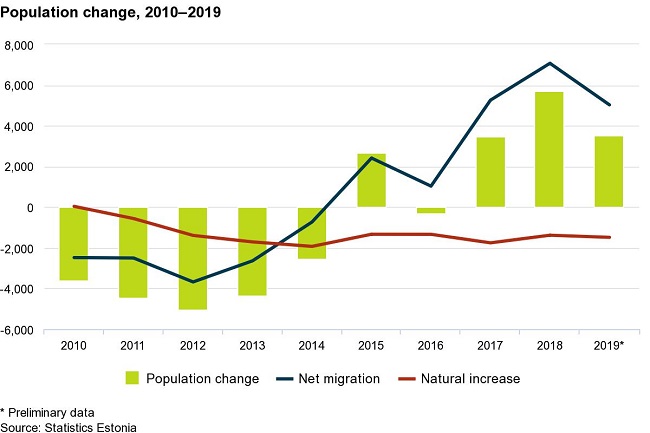Analytics, Demography, Estonia, Good for Business, Statistics
International Internet Magazine. Baltic States news & analytics
Saturday, 03.01.2026, 06:01
Estonia: Immigration has been driving population growth for five years
 Print version
Print versionIn 2019, there continued to be more deaths than births and natural increase remained negative (1,490). This was to be expected, as the number of older people in the population is high and the number of women in childbearing age is decreasing. The factor behind population growth in 2019 was positive net migration: 5,030 more people immigrated to Estonia than emigrated.
13,900 children were born in Estonia in 2019, which is more than 400 fewer children than the year before. The decrease in the number of births was to be expected, as the small generation born in the 1990s has reached active family formation age. It is likely that fertility continued to be affected by the increase in the third child allowance, as the number of births was higher than in 2017, although the number of women is smaller compared to 2017. The subsequent analysis will show whether the drop in 2019 was due to the decreasing number of first and second children or the number of third children also decreased compared to 2018.
There were 15,390 deaths in 2019. Despite the increase in the number of older people, the number of deaths has remained stable in the past decade due to increasing life expectancy.

- 28.01.2022 BONO aims at a billion!
- 13.02.2021 Моя жизнь в газете. Очерки по новейшей истории Латвии. Глава 1
- 30.12.2020 Накануне 25-летия Балтийский курс/The Baltic Course уходит с рынка деловых СМИ
- 30.12.2020 On the verge of its 25th anniversary, The Baltic Course leaves business media market
- 30.12.2020 Business Education Plus предлагает анонсы бизнес-обучений в январе-феврале 2021 года
- 30.12.2020 EU to buy additional 100 mln doses of coronavirus vaccine
- 30.12.2020 ЕС закупит 100 млн. дополнительных доз вакцины Biontech и Pfizer
- 29.12.2020 В Латвии вводят комендантский час, ЧС продлена до 7 февраля
- 29.12.2020 Latvia to impose curfew, state of emergency to be extended until February 7
- 29.12.2020 Linde Gas открывает завод в Кедайняйской СЭЗ








 «The Baltic Course» Is Sold and Stays in Business!
«The Baltic Course» Is Sold and Stays in Business!

